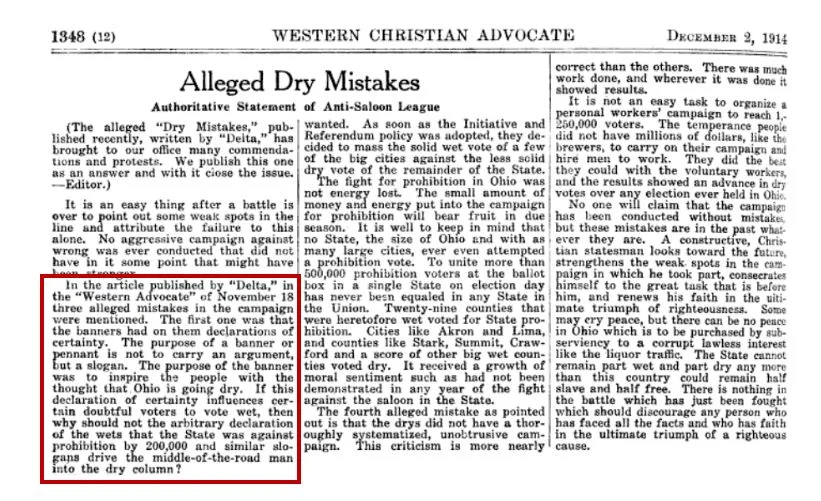Antique Ohio is Going Dry Pennant | Distributed by the Anti-Saloon League in Anticipation of Prohibition and the 18th Amendment | Circa 1914
Antique Ohio is Going Dry Pennant | Distributed by the Anti-Saloon League in Anticipation of Prohibition and the 18th Amendment | Circa 1914
Frame Size (H x L): 18” x 31”
Pennant Size (H x L): 9” x 17” with 5” ties
Offered is an antique pennant with an “OHIO IS GOING DRY” overprint. It is made of felt and includes a green field with white lettering. The “OHIO” overprint is in a large font, and becomes shorter when viewed from left to right. In contrast, the “IS GOING DRY” overprint is in a small font, and is a consistent height.
This pennant was distributed by the Anti-Saloon League, an organization that lobbied for prohibition in the United States. A reference to this pennant is made in the December 2nd, 1914 issue of Western Christian Advocate, which states the following (see the image):
In the article published by “Delta,” in the “Western Advocate” of November 18 three alleged mistakes in the campaign were mentioned. The first one was that the banners had on them declarations of certainty. The purpose of a banner or pennant is not to carry an argument but a slogan. The purpose of the banner was to inspire the people with the thought that Ohio is going dry. If this declaration of certainty influences certain doubtful voters to vote wet, then why should not the arbitrary declaration of the west that the State was against prohibition by 200,000 and similar slogans drive the middle-of-the-road man into the dry column?
The Anti-Saloon League was founded in Oberlin, Ohio in 1893, and its first offices were located in Columbus. In 1909, it moved to nearby Westerville, Ohio, a city with a reputation for supporting temperance and nicknamed the “Dry Capital of the World.”
Initially, the League focused on appealing to local churches for carrying out its motto of “The Saloon Must Go.” And as this message took hold—via pamphlets, fliers, newspapers, and pennant—it focused on electing politicians who supported its cause. At the League’s 20th anniversary celebration, held in Columbus, Ohio in 1913, it announced its campaign towards a constitutional amendment prohibiting the sale of alcohol. This effort culminated in the passage of the 18th Amendment on October 28th, 1919.
In part because of the League’s power in Ohio, Ohio went dry on May 27th, 1919, nearly six months prior to the passage of the 18th Amendment. Interestingly, almost all of Columbus’s three-hundred bars stopped serving alcohol on May 24th, as this was when Ohio’s liquor license expired. Only nine bars extended their permits, so as to cover and capitalize on the period from May 24th to the midnight of May 27th.
Conservation Process: This pennant was hand sewn to cotton fabric, and both were hand sewn to a mounting board. To prevent the black dye in the cotton fabric from seeping into the pennant, it was first washed in a standard wash and then in a dye setting wash. The pennant is positioned behind Optium Museum Acrylic.
Frame: This offering is in our Medium Gold with Flat Profile Frame.
Condition Report: The overprint has some minor cracks, most notably on the first “O” of “OHIO.” In all other respects, this pennant is an excellent condition and presents wonderfully.
Collectability Level: The Great – Perfect for Rising Collectors
Date of Origin: 1914





